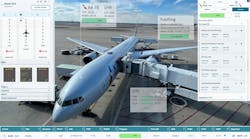Contrary to our collective best wishes on behalf of improving aviation security, things did not get much better while you were on vacation. While everybody loves to rag on TSA, including yours truly, it turns out that a combative and somewhat arbitrary U.S Congress deserves at least an equal dab of scorn for how the system works... Or doesn't. In particular, even though US passenger traffic has significantly increased since the post-9/11 depression, Congress has refused to change the original cap on screeners that was imposed when TSA first opened its doors. Certainly there is an argument to be made that the existing screeners can only process the throughput presented to them by constantly changing and sometimes debatably effective technology, but until such time as those technologies are perfected – presumably sometime just this side of never – the need for manual screening persists. Recall the installation, and then speedy removal of the puffer machines due to enormously high false alarm rates, and more recently the scrapping of the highly vaunted screening technology due to privacy concerns.
The late Sen. Frank Lautenberg (D-N.J.) firmly believed that removing the arbitrary cap would speed up security lines, while Republicans are trying to replace Federal screeners with private-sector contractors, and to cut part-time screeners, who are not subject to the cap, but are necessary at many airports with widely separated peak loads. To their credit, TSA also tried to reduce some of the backlog with their attempt to allow small knives, and notwithstanding any debate on the wisdom of that move, or the clumsy manner in which it was brought forth, Congress forced the agency to kill the proposal.
One place where there is no cap, and some suggest there should be, is on some 15,000 TSA bureaucrats to support 457 airports... That's an average of 32.8 bureaucrats per airport. Having been one of those myself long ago, I know how hard most of those people work – and some who don't, and some of the reasons for their low position on polls for best/worst places to work, and their extraordinarily high rate of career turnover. I don't recall if there has been a recent GAO study of TSA’s managerial structure and effectiveness, but it certainly bears some serious new attention.
One program in particular we recently discussed in this space is the roughly $900 million spent over six years (so far) on the SPOT behavior detection efforts. TSA’s own mother ship, the DHS IG, says there is no comprehensive training program for its 2,800 screeners, and no way of assessing their effectiveness. And yet they continue to receive allegations of racial profiling, as well as have no means of showing measurable results. I have no quarrel with trying something that sounds like a good idea – I think it was worth a serious try. However, I do have a problem spending six years – half of TSA’s existence - and nearly $1 Billion-with-a-Capital-B, which still has not bought them a clue about the usefulness of the program. I, for one, am no longer impressed by the usual TSA drone about “random and unpredictable measures” or “multilayer security measures both seen and unseen”. A crack team of 32.8 bureaucrats should be able to figure out that this one hasn’t met its expectations.


